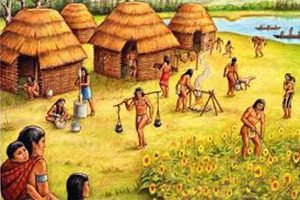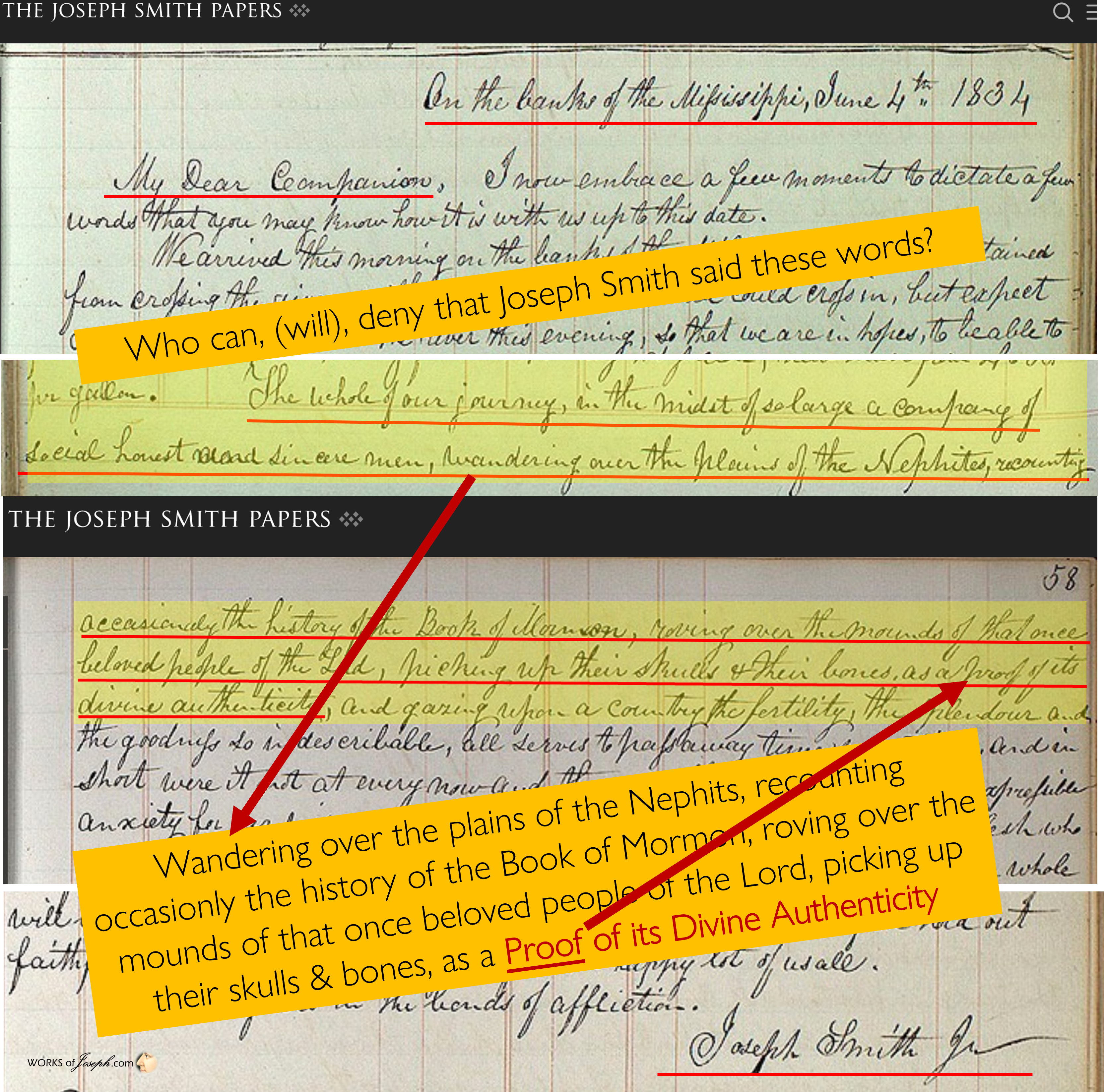THE ADENA CULTURE 1500 BC TO 300 AD
 “Zion’s Camp started in Kirtland, Ohio and ended in Independence, Missouri. The Camp traveled areas occupied by both the Hopewell (see p. 535) and Adena (see p. 452) cultures.” Annotated Book of Mormon ZION’S CAMP AND THE “PLAINS OF THE NEPHITES” Illustration by Rod L Meldrum
“Zion’s Camp started in Kirtland, Ohio and ended in Independence, Missouri. The Camp traveled areas occupied by both the Hopewell (see p. 535) and Adena (see p. 452) cultures.” Annotated Book of Mormon ZION’S CAMP AND THE “PLAINS OF THE NEPHITES” Illustration by Rod L Meldrum
1. “The Adena culture existed from 1500 BC to 300 AD, in a time known as the Early Woodland period. The Adena culture refers to what were probably a number of related Native American societies sharing a burial complex and ceremonial system. The Adena lived in an area including parts of present-day Ohio, Indiana, West Virginia, Kentucky, New York, Pennsylvania and Maryland.
2. “Adena sites are concentrated in a relatively small area (see pink area in map to the left)- maybe 200 sites in the central Ohio Valley, with perhaps another 200 scattered throughout the other states, although they may once have numbered in the thousands. The importance of the Adena complex comes from its considerable influence on other contemporary and succeeding cultures. The Adena culture is seen as the precursor to the traditions of the Hopewell culture, which are sometimes thought as an elaboration, or zenith, of Adena traditions.

3. “The Adena were notable for their agricultural practices, pottery, artistic works and extensive trading network, which supplied them with a variety of raw materials, ranging from copper from the Great Lakes to shells from the Gulf Coast. The Adena culture was named for the large mound on Thomas Worthington’s early 19th-century estate called ‘Adena’, in Chillicothe, Ohio.
4. “The Miamisburg Mound is the best known, but least understood major prehistoric Indian feature in Ohio. It is the largest conical shaped burial mound or earthwork of its kind east of the Mississippi, and the most recognizable land mark in in the city of Miamisburg.”
5. “The origin of these very advanced peoples is
not known. They arrived or developed in the Ohio river valley beginning 1500 BC They were the first to domesticate plant food such as squash, sunflower and pumpkins. They lived in permanent settlement near streams. Sometimes their villages were enclosed with earthen walls from four to five feet in height. Their principal weapon was the spear. The Adena Indians were the first in Ohio to build earthworks and burial mounds giving rise to their popular name, Mound Builders.
6. “This civilization, unlike the Hopewell Mound Builder civilization which followed them tended to create their mounds in conical form. Both buried their honored dead within large earthen mounds.

7. “Their culture strongly correlated with the Book of Mormon Jaredite people in time frame and location in relation to the Nephites and several criteria. Their skills were advanced and many of their remains were truly monumental.” The Book of Mormon in America’s Heartland page 100 by Rodney Meldrum
The Adena Culture of the Northeast
“From the years of about 1000 B.C. to about 1 A.D. the Adena people were a group of well-organized societies that lived in parts of present-day Ohio, Indiana, Wisconsin, West Virginia, Kentucky, Pennsylvania, Maryland, and New York.
The Adena people were not a single tribe, but rather, a group of indigenous people that shared similarities in artifact style, architecture, and other cultural practices, including a common burial and ceremonial system that included mound building. The Adena were the first group of “mound builders,” a practice which spanned several cultures over a period of about 20 centuries.

Building these mounds was a monumental task as these ancient people didn’t use the wheel and had no horses. Large amounts of earth would have to have been moved by the basket-load to the mound site. Probably, for this reason, the mounds were used more than once. Over the years, more earth was brought in and the mounds were built higher and higher, containing multiple burials at different levels.
Most of the mounds range in size from 20 to 300 feet in diameter. However, the conical-type Grave Creek Mound in Moundsville, West Virginia, is much larger. The largest of Adena’s burial mounds, standing at 62 feet high and is 240 feet in diameter, is thought to have been built over a period of 100 years or more.” Legends of America by Kathy Weiser-Alexander, October 2018 Full article here:

“The first land settled by the Jaredites was Moron… Now the Nephite land in the borders, by the seashore on the edge of the wilderness was called by them Moroni… Moroni as meaning ‘belonging’ to Moron… the old -i ending being the most familiar and unchanging suffix from the oldest Egyptian and Babylonian to modern Arabic… Both the time—the very end of Jaredite history—and the place—the outer borderland—agree in bringing the two names Moron and Moroni together in a cultural overlap…” Lehi in the Desert Hugh Nibley
“Adena burial mounds are common in the Ohio River Valley region. It was not, however, until 1901 that the first Adena mound was excavated for historical purposes by William C. Mills of the Ohio State Museum (Mills, 1902). This mound was on the estate of Thomas Worthington (Governor of Ohio, 1814- 18) in Ross County, a mile northwest of Chillicothe, Ohio. Governor Worthington gave the name “Adena” (probably from the Hebrew “Adinah”) Presumably he meant to imply “nothing lacking” or, freely translated, “paradise.” The name “Adena” was adopted by archeologists to refer to the prehistoric Indians who built such mounds…This area became one of the favored locations of these people between 800 B.C. and A.D. 800…” SMITHSONIAN INSTITUTION Volume 112 1960 Number 3441 WELCOME MOUND AND THE EFFIGY PIPES OF THE ADENA PEOPLE By Frank M. Setzler
Mormon and his son Mormon travel from Cumorah to Zarahemla. Did they see remnants of the Adena culture? Mormon 1:6

“Mormon refers to the land of Zarahemla as “the land southward.” What is his frame of reference? Many times in the text, Mormon refers to Zarahemla as the land northward. For example, he explained that “Now the land south was called Lehi, and the land north was called Mulek, which was after the son of Zedekiah; for the Lord did bring Mulek into the land north, and Lehi into the land south” (Helaman 6:10). But here, he refers to Zarahemla as “the land southward.” Obviously he is writing from a reference point north of Zarahemla… Starting from the northern area near the land Antum, Mormon and his father would travel south to reach the Allegheny River, then south to join the Ohio River, then south along the Ohio River until it moves more westerly. Only once he reaches the head of Sidon would he turn north. Mormon wouldn’t be looking at Google Earth or a map of the globe to determine the relative latitude of his destination (although, even technically, Zarahemla is south of his starting point). Mormon would refer to the direction they headed; i.e., they went “into the land southward” from the perspective of someone leaving from the Cumorah area. Later, Mormon will write about how the Lamanites drove the Nephites northward, back to the area of his homeland. During his field trip, the boy Mormon was amazed at what he saw. “The whole face of the land had become covered with buildings, and the people were as

numerous almost, as it were the sand of the sea.” Mormon 1:7. The whole face of the land would be the areas through which Mormon traveled. Imagine what it would be like for a young boy to leave his homeland and “see the world” with his parents.
What does it mean that the “land had become covered with buildings” in this context? The Book of Mormon text includes over 100 references to “build,” “building,” and “buildings.” Recall how Dr. Roger Kennedy, the former director of the Smithsonian’s American History Museum, explained this term. “Build and building are also very old words, often used in this text [his book] as they were when the English language was being invented, to denote earthen structures. About 1150, when the word build was first employed in English, it referred to the construction of an earthen grave. Three hundred and fifty years later, an early use of the term to build up was the description of the process by which King Priam of Troy constructed a “big town of bare earth.” So when we refer to the earthworks of the Ohio and Mississippi Valleys as buildings no one should be surprised.” Roger G. Kennedy, Hidden Cities: The Discovery and Loss of Ancient North American Civilization.
All along the Ohio and Mississippi Rivers, young Mormon would have passed by these earthworks and mounds. Most of the hundreds of thousands of sites have long since been destroyed, but many can still be visited today. Along the Ohio River, there are sites such as the one in Moundsville, West Virginia that I discussed in the Mosiah chapter. Other sites include Marietta and Portsmouth, Ohio, the Mann site near Evansville, Indiana, and several in Illinois.” Moroni’s America page 241-42

In the painting right, I show Grave Creek Mound at Moundsville, WV, which can be seen today. “Grave Creek Mound is the largest conical type of any of the mound builder structures. Construction of the mound took place in successive stages from about 250–150 B.C., as indicated by the multiple burials at different levels within the structures. In 1838, road engineers measured its height at 69 feet and its base as 295 feet. Originally a moat of about 40 feet in width and five feet in depth, with one causeway across it, encircled the mound. Inside the mound, archaeological researchers have discovered Adena Hopewell remains and ornaments, along with a small sandstone tablet.” Wikipedia Grave Creek Mound

“Mormon’s father may have taken his son to visit historic sites along tributaries, such as the Scioto and Tennessee Rivers. He could have visited the ancient city of Nephi, [Waters of Mormon] the places where the sons of Mosiah taught the gospel to the Lamanites, and Alma’s land of Helam. He could have visited the battlefields described in Alma. The journey would be the perfect preparation for the future prophet and historian who would compile the history of Lehi’s descendants.” Moroni’s America page 242
In Mormon 1:12 it speaks about peace in the land for four years. This time would have been utilized by young Mormon to read, write, and study more about these events that he was commanded to record on the plates. At the age of 16 Mormon now large in stature, was made the commander of the Nephite army. In this painting you can see the “Title of Liberty” hoisted at the top of the fort in Moundsville, as young Mormon would continue to follow this pledge of; “In memory of our God, our religion, and freedom, and our peace, our wives, and our children” Alma 46:12.
Mormon and his son Moroni were direct descendants of Manasseh (3 Nephi 5:20). Moroni would bury the plates, which Joseph Smith, a direct descendant of Ephraim, would be led to uncover. Once again the covenant of the House of Joseph and the House of Israel would be upon the Promised Land.

Featured Image about culture time frames at the very top is based on Sacred Calendars by JohnPratt.com
See a comprehensive article about the Adena Culture from Calvin Hamilton click Here:






